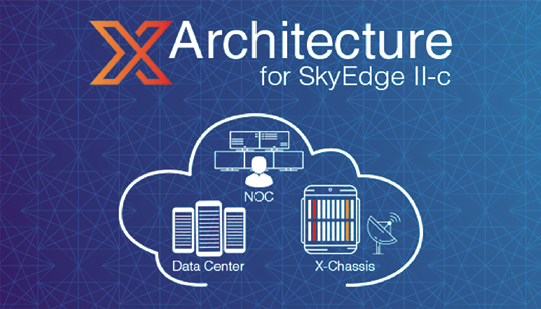To articulate the impact of High Throughput Satellites (HTS) on the satellite ecosystem is a most challenging task. After years of satellite communications existing as a niche market, useful primarily where terrestrial communications solutions were not feasible, satellites can now compete in high-capacity markets.

Hastening this trend are the vastly larger amounts of capacity now available, thanks to HTS. This abundance has lowered the cost of satellite bandwidth where such can now compete with terrestrial solutions.
In parallel, increased worldwide demand for data services has opened the door for expansion to new markets and services. Along with the built-in strengths of a satellite solution—massive throughput capacity, a worldwide footprint and rapid deployment—HTS satellites benefit from faster data rates and a four-to-tenfold reduction in the cost-per-bit.
In this new era, the satellite industry is poised to rattle the traditional hegemony of terrestrial communications in non-rural markets.
Consumer broadband is, by far, the most widely used market for HTS today and will most likely continue to be so. However, the capacity surge that HTS provides lends itself to a much broader set of applications, including those with the potential for higher margins than what consumer broadband can offer.
These other markets are maturing and are expected to grow significantly over the next few years, exploiting abundant HTS capacity. Cellular backhauling, and in particular 3G/LTE backhauling, is showing high growth as cellular networks expand to rural and remote regions worldwide. Another high-growth market is mobility, due to the increasing demand for passenger in-flight connectivity and communications for vessels at sea.
Implications Of Increased HTS Capacity
HTS architecture is based on many spot beams (10-100 beams) covering a geographic area rather than the wide beams implemented in traditional satellites. By reusing frequencies, in a method similar to that of cellular networks, spot beam satellites are able to provide much more capacity than standard wide-beam satellites.
The primary impetus for developing HTS was to increase available bandwidth at a lower price per bit. A typical HTS system is capable of delivering 20 to 100 Gbps of data, servicing tens to hundreds of thousands of users. This provides 10 to 100 times the capacity of traditional wide-beam coverage satellites, all the while maintaining similar launch costs. The following example illustrates how the expanded capacity of HTS impacts ground segment equipment:
Scenario A: A traditional wide-beam satellite with a payload of 1.1GHz, or approximately 2Gbps, is composed of a single wide beam. Baseband equipment in one gateway lights up the wide beam.
Scenario B: A high-throughput satellite with a payload of 10.5 GHz, or approximately 21Gbps, is composed of 21 spot beams. Baseband equipment is spread over three gateways to light up the 21 beams.
Note that HTS provides huge growth opportunities thanks to the additional capacities. The initial CAPEX investment in scenario B, however, is significantly higher than in scenario A. This is due to the fact that hub baseband equipment deployment is required to support transmission in each of the spot beams rather than in just supporting a single transmission when using a wide beam.
For satellite service providers, this fact has implications for the business model. In many cases, service provides are unable to fund the initial high CAPEX investment for the hub baseband equipment that is required for HTS at its service start and during service ramp-up. This essentially forces satellite operators to partner with ground segment providers to deliver baseband transmission capabilities on all of the beams to ensure immediate coverage. The result is a shift in the satellite business model from purely selling capacity (MHz) to offering managed services (Mbps).

The need for virtual network operators (VNOs) with various business models that require support is also being witnessed. By equipping VNOs with a logical or physical separate network and independent management capabilities, they can manage their customer services and bandwidth requirements across multiple beams without the upfront investment in gateway infrastructure.
For satellite service providers to host VNO services in an HTS environment, greater ground segment architecture flexibility is required. One option for supporting this model is to move VNO management to a cloud service, which enables a cross-beam network view of all subscribers.
The Shifting Role Of Ground Segment Architecture
As HTS networks require deploying ground segment equipment to cover multiple beams, often in multiple gateways, a substantial initial investment is needed. This expense can be offset by new opportunities for using the large amount of bandwidth, increasing not only the satellite fill ratio, but more importantly, improving revenue-per-bit.
An architecture that addresses the unique opportunities and challenges of HTS include:
Bandwidth management—Although HTS provides abundant aggregate bandwidth, it divides that bandwidth into many geographically separated beams. This has implications for fixed satellite services, providing multiple choices for beam selection due to adjacent overlapping beams. For service continuity in mobility applications, automatic beam-switching is required. To guarantee the expected bandwidth service level agreements, a flexible planning and allocation method should be in place.

Support for Multiple Markets—The surge of capacity and the growing need for data connectivity brings opportunities for multiple new markets, each with its specific needs. The architecture must support fast-growing HTS markets such as consumer broadband, cellular 3G/LTE backhauling, mobility and enterprise. Ideally a single platform should provide support for service expansion to any fixed or mobility market. Tailored VSATs optimized for the various market needs must be available as part of the offering.
Cloud-based Distributed Architecture—When planning support for dynamic resource allocation among applications or across beams, there is great value in rethinking the ground segment architecture. On one hand, the ground segment architecture must be sufficiently flexible to support baseband equipment located in multiple gateways. On the other hand, it is advisable to locate data processing servers (performing acceleration, routing, QoS and management functions) in a cloud data center to gain operational efficiency. This requirement is best met with a cloud-based distributed architecture and built-in support for next-generation software-defined networking.
Centralized Global NMS—The network needs to be easily and remotely controllable by a single global and centralized network management system. It should enable full configuration, control and monitoring of all hub elements and remote terminals, regardless of their physical location.
Network Scalability and Flexibility —The architecture must easily and cost-effectively facilitate business growth. It should be easy to provide additional geographic coverage or additional satellite bandwidth capacity to support a growing subscriber base or expand your business to new markets. The architecture should also present operations at a level of abstraction that makes the complexities of spot beam satellites transparent to the service provider.
Reduced OPEX/CAPEX
Equipment must be carefully designed to support the skyrocketing need for additional capacity. Rack space and power costs can be significant, therefore a cost-effective ground segment should be sufficiently dense to minimize footprint and power consumption. Another cost reduction mechanism is remote operation, reducing the overhead of in-person site visits. This minimizes manual intervention in LAN and RF configuration, shortens activation time and improves reliability.

These attributes, implemented properly, can make all the difference when charting the course of your satellite network’s growth. Gilat Satellite Networks has recently launched a new ground segment architecture designed to address the exciting opportunities that lie ahead with HTS. For information regarding X-Architecture for SkyEdge II-c, please access www.gilat.com/X-Architecture
Doreet Oren ([email protected]) is Director of Product Marketing for Gilat Satellite Networks. In this role Oren is responsible for defining product positioning, messaging and go to market strategies and is responsible for market research and analyst relations.


